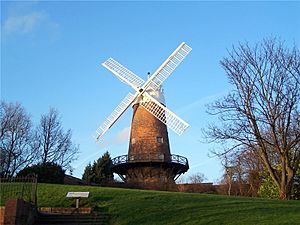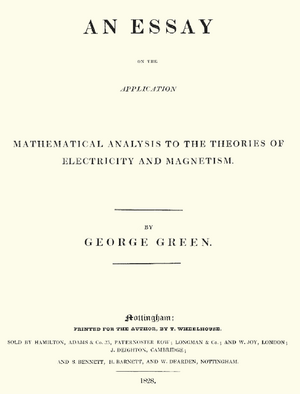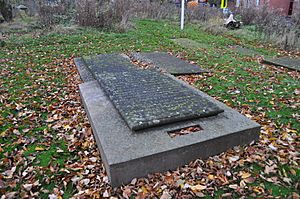George Green (mathematician) facts for kids
Quick facts for kids
George Green
|
|
|---|---|
| Born | 14 July 1793 Sneinton, Nottinghamshire, England
|
| Died | 31 May 1841 (aged 47) Nottingham, Nottinghamshire, England
|
| Alma mater | Gonville and Caius College, Cambridge (BA, 1838) |
| Known for | Green measure Green's function Green's identities Green's law Green's matrix Green's theorem Liouville–Green method |
| Scientific career | |
| Fields | Mathematics |
| Institutions | Gonville and Caius College, Cambridge |
| Influenced | Lord Kelvin Julian Schwinger |
George Green (born July 14, 1793 – died May 31, 1841) was a brilliant British mathematician and physicist. He wrote a very important book in 1828 called An Essay on the Application of Mathematical Analysis to the Theories of Electricity and Magnetism.
In this book, he introduced ideas that are still used in physics today. These include Green's theorem, the concept of potential functions, and Green's functions. George Green was the first person to create a mathematical theory for electricity and magnetism. His work helped other famous scientists like James Clerk Maxwell and Lord Kelvin.
What makes Green's story amazing is that he taught himself almost everything he knew. He only went to school for about one year when he was a child.
| Top - 0-9 A B C D E F G H I J K L M N O P Q R S T U V W X Y Z |
Early Life and Learning
George Green spent most of his life in Sneinton, England. This town is now part of the city of Nottingham. His father, also named George, was a baker who built and owned a brick windmill. This mill was used to grind grain into flour.
As a young boy, George Green was not very strong and didn't like working in his father's bakery. However, like many children at that time, he probably started working daily from a very young age to help his family.
A Short Time at School
In the early 1800s, not many children in Nottingham went to school. Most schools were Sunday schools run by the church, and children usually attended for only a year or two.
Green's father noticed that young George was very smart. Since the bakery was doing well, he enrolled George in Robert Goodacre's Academy in March 1801. Robert Goodacre was known for teaching science and mathematics. However, the school's math lessons were quite basic.
George Green only stayed at the academy for one school year. People at the time thought he had learned everything they could teach him. This means his later advanced math skills came from his own learning, not from this school.
Moving to the Mill
In 1807, George Green's father bought land in Sneinton. He built a large "brick wind corn mill" there, which we now call Green's Windmill. This mill was very advanced for its time.
However, it needed constant care, almost 24 hours a day. This became George Green's main job for the next twenty years.
Adult Life as a Miller
George Green found working at the mill boring and tiring. Grain was always arriving, and the mill's sails had to be adjusted all the time. This was to catch the wind just right and also to prevent damage in strong winds.
The heavy millstones inside the mill could wear down or even cause a fire if they ran out of grain to grind. Every month, these stones, which weighed over a ton, had to be replaced or fixed.
Family Life
In 1823, Green started a relationship with Jane Smith. She was the daughter of the mill manager. Even though they never officially married, Jane became known as Jane Green. They had seven children together. George Green made sure his family was provided for in his will.
Discovering Knowledge
When Green was thirty, he joined the Nottingham Subscription Library. This library was special because it was only for about a hundred members. It had many specialized books and journals that were hard to find elsewhere. This library was probably where Green found the advanced math books he needed to teach himself.
His Famous Essay
In 1828, Green published his most famous work, An Essay on the Application of Mathematical Analysis to the Theories of Electricity and Magnetism. He paid for it himself because he felt it would be too bold for someone without a formal math education to send it to a major journal.
Only 51 people bought the essay, mostly friends who probably didn't understand it. However, a wealthy mathematician named Sir Edward Bromhead bought a copy. He saw how brilliant Green's work was and encouraged him to do more math. Green didn't believe the offer was serious at first and didn't contact Bromhead for two years.
Becoming a Mathematician
When Green's father died in 1829, he left a lot of his wealth and land to George. This meant George, who was 36 years old, no longer had to work at the mill. He could finally focus on studying mathematics.
Studying at Cambridge
Friends from the Nottingham Subscription Library kept telling Green he should get a proper university education. Sir Edward Bromhead especially urged him to go to Cambridge University.
In 1832, at almost 40 years old, Green started as a student at Gonville and Caius College, Cambridge. He was worried about not knowing Greek and Latin, which were required. But he found them easier to learn than he thought. He even won the first-year math prize! In 1838, he graduated with a BA degree. He was the 4th highest-scoring student in his class.
A College Fellow
After graduating, Green was chosen as a fellow of the Cambridge Philosophical Society. This was a great honor. The Society already knew about his important essay and other writings.
For the next two years, Green had an amazing chance to read, write, and discuss his scientific ideas. During this short time, he published six more papers. These papers explored ideas about how water moves, sound, and light.
Later Life and Legacy
Green became quite ill in his last years at Cambridge. In 1840, he returned to Sneinton and passed away a year later.
During his lifetime, Green's work wasn't widely known by other mathematicians. But in 1845, four years after his death, a young scientist named William Thomson (who later became Lord Kelvin) discovered Green's essay. Thomson realized how important Green's ideas were and helped make them famous among other mathematicians.
Green's Lasting Impact
Green's work on how waves move in a canal (called Green's law) was very advanced. His research on light waves also led to important concepts. Green's theorem and Green's functions became key tools in classical mechanics.
Later, in 1948, Julian Schwinger used Green's functions in his groundbreaking work on electrodynamics. This work helped him win the Nobel Prize in 1965. Green's functions also proved useful in understanding superconductivity.
In 1930, Albert Einstein visited Nottingham and said that George Green was 20 years ahead of his time!
Remembering George Green
Today, many places honor George Green. The George Green Library at the University of Nottingham is named after him. It holds many science and engineering books.
In 1986, Green's Windmill was restored. It now works again as a 19th-century windmill. It's also a museum and science centre dedicated to George Green.
There is even a memorial stone for Green in Westminster Abbey, right next to the graves of Sir Isaac Newton and Lord Kelvin. This shows how important his contributions were to science.
How Did He Learn So Much?
Historians are still not sure how Green learned about the latest math ideas. Nottingham didn't have many places for advanced learning. What's even more puzzling is that Green used a type of calculus (a branch of math) that was not common in England at the time.
This type of calculus, developed by mathematicians like Laplace and Poisson from France, wasn't even taught at Cambridge. Yet, Green not only knew about these ideas but also made them even better!
It's thought that perhaps only one person in Nottingham, John Toplis, a headmaster who loved French mathematics, might have helped Green. But mostly, George Green was a true self-taught genius.
Images for kids
See also
 In Spanish: George Green (matemático) para niños
In Spanish: George Green (matemático) para niños






